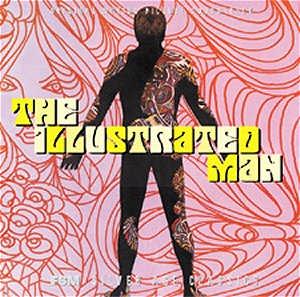Jerry GOLDSMITH
The Illustrated Man
OST
FILM SCORE MONTHLY [42:01]

Available from the magazine Available from the magazine Film Score Monthly, 8503 Washington Boulevard, Culver City, CA 90232 USA; toll free: 1-888-345-6335 overseas: 310-243-9595; fax: 310-253-9588.; info@filmscoremonthly.com
The Illustrated Man (released 1969, music scored summer 1968) is one of those films which are ingenious in conception but less successful in execution. The screenplay adapts four early Ray Bradbury stories, cleverly using one of them, the title work, as a frame in which to set the others. Rod Steiger plays the title character, a man covered not with tattoos, but with "living illustrations". Stare at these too long and they come to life, revealing stories of the past, present or future. This was essentially a venture into the supernatural/fantasy anthology movie, a popular format in the 1960's and 70's, especially with such British studios as Amacus and Hammer. Even so with its poetic mood, unsettling casting of the same actors as characters with the same names in each of the four stories, and twist ending akin to the British pioneer in the genre, Dead of Night (1945), The Illustrated Man proved perhaps too offbeat for its own good and was not a commercial success. It was as the highly informative and clearly written booklet by Jeff Bond and Lukas Kendall points out, considered to be a very interesting failure. Jerry Goldsmith himself rated the score highly, and Ray Bradbury considered it the best thing about the film. Indeed, the following year the writer and composer worked together on the cantata Christus Apollo.
The Illustrated Man was Goldsmith's first fantasy/SF score since Planet of the Apes (1968), though he had scored radio adaptations of Bradbury stories in the 1950's; "Season of Disbelief" and "Hail and Farewell" (both 1956). He employed some of the same serial techniques he used for Apes, though overall The Illustrated Man is a broader ranging score, also utilising a lovely folk-like melody with wordless female vocals and atonal electronics with a sound which may be familiar from the more popular SF adventure Logan's Run (1976).
This is an often low-key score, chamber-like score, Goldsmith in places cutting his forces down from a full string section to a handful of players. There are no trumpets, four French horns. With nine woodwinds including electric alto flute, alto recorder, plus celesta, various guitars and sitar on several cues the music has a unique, warm yet alien sound world. This is augmented by avant-garde performance techniques and the use of tape delays, sometimes applied to a single instrument, sometimes to the entire orchestra. The few moments of climactic action are accompanied by ferocious dramatic writing with biting strings, powerful percussion and brass. Remotely beautiful yet with a strange thread of off-kilter darkness to many passages, The Illustrated Man is a lyrical nightmare and a significant addition to the catalogue of classic Goldsmith SF and fantasy scores.
The booklet notes that the score, recorded by Dan Wallin with close-miking and wide stereo separation, has been stored on ½-inch three track magnetic tape and preserved in excellent condition. The electronic material was recorded in mono on 35mm magnetic film and likewise survived with little deterioration. The result is an album which sounds as good as any transfer of late 1969's film music is ever likely to sound. By Film Score Monthly standards this is a short album at 42 minutes as unusually there are no bonus cues, out-takes, alternate tracks or source recordings. Nevertheless the quality, not the quantity is the important thing. This album is an affirmation of just how subtle and imaginative a composer Goldsmith once was in the science fiction and fantasy field. The Illustrated Man is a world away from The Hollow Man (2000), and infinitely the better for it.
Gary S. Dalkin

Return to Index